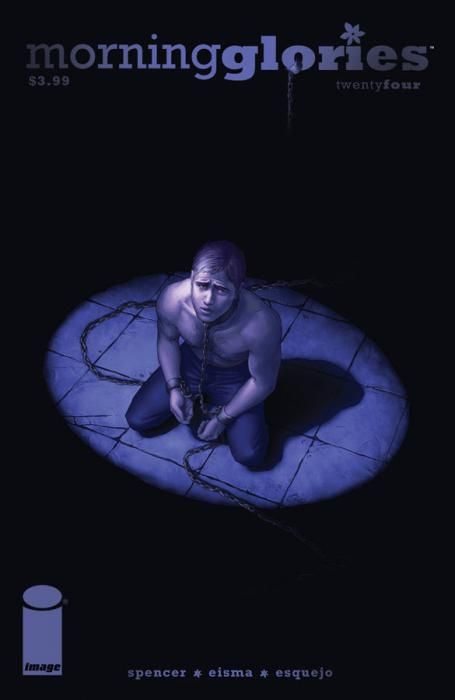"Morning Glories" #24 is a double-sized issue, the first of its size since "Morning Glories" #1, and Nick Spencer and Joe Eisma make daring and surprising use of this larger canvas. The story focuses almost exclusively on one of the original Glories, Ike, instead of any number of characters from the recently expanded cast. Although many mysteries remain and new questions sprout as usual, overall "Morning Glories" #24 is more about the answers, partly because answers are what Ike wants. His entitlement, impatience and sense of ill-usage probably hilariously echo the feelings of some "Morning Glories" readers.
"Morning Glories" #24 begins, appropriately, with Ike's birth and ends on a scene in the present-day, but the path of the story is nonlinear, skipping frequently and easily across the years, anchored only to the relationship between Ike and Abraham. For readers who are fans of Ike, "Morning Glories" #24 delivers on every front. Ike's arrogant but hilarious turns of phrase are present, along with non-PC jokes and outrageous rich-boy behavior. There's six-year-old Ike, developing an opinion about God, and ten-year-old Ike acting like a normal kid at Coney Island. For those who hate Ike or love-to-hate him, there's a lot of material to make Ike more sympathetic without lessening any of his edge.
Little Ike tugs at the reader's heartstrings because of Eisma's skill in drawing these younger, cuter versions of the original bad boy of "Morning Glories," but Spencer's tone doesn't swerve into too much "Poor Little Rich Boy" sentimentality. A distant father and a rebellious son is a well-worn dynamic, but none of it feels stale, because Ike takes everything deadly seriously while affecting not to take anything seriously at all.
The ending cliffhanger of "Morning Glories" #24 is spread out over seven pages. It's a daring choice that runs a strong risk of thinning the suspense, but Spencer and Eisma carry it off, making fantastic use of all that extra space. This long ending sequence beings with panel that takes up a whole page. It's a "Whoa!" moment, and typically this page would be the best ending point. Six more pages follow, however, as Spencer and Eisma wrap in a much harrowing scene from one year ago before returning to the present.
The particular revealed event feels inevitable, both because it was heavily foreshadowed and because of the significance of its inversion of Judeo-Christian religious symbolism. What occurs in those pages is within that category of crimes so distinctly against justice and nature that the Ancient Greeks created the Furies to punish them. Here, Fate and Fatality are one. This one act ties together Ancient Greek Tragedy and the Biblical themes of Sacrifice. Spencer harnesses these human obsessions so that they drive blood through the heart of the story and into the mythology of the series.
These critical pages are staged exquisitely by Eisma and Sollazzo. There is very little dialogue, so almost all the important information is in the visuals. Eisma's skill with facial expressions, body language and narrative pacing doesn't fail to impress in this scene. Even small choices, like how Eisma tilts a panel after Ike reads a document, signal an ominous change in knowledge and state of mind. Sollazzo's specific palette of shadowy cool colors, reminiscent of the hours of dawn or dusk, match Spencer's narrative preoccupations with ritual, reverence and the arcane, about things just out of sight but believed.
It's clear that much of the larger story arc was building towards this climactic scene, and nothing else in "Morning Glories" #24 can match the pathos and horror of its mixture of love, longing and violence. Reading those pages, one can't help be moved and appalled, enthralled with a chapter of "Morning Glories" that is near-perfect in plotting and execution. It's a tale that will reward the faithful.

